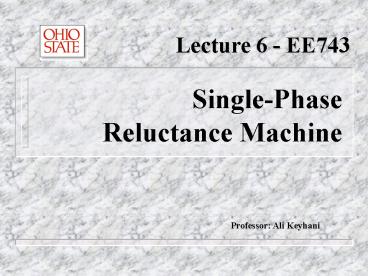Lecture 6 EE743 - PowerPoint PPT Presentation
1 / 33
Title:
Lecture 6 EE743
Description:
... from a north pole of a magnet into the air toward the south pole (stator winding ... enters the air gap from the north pole of the magnetic system of the rotor. ... – PowerPoint PPT presentation
Number of Views:30
Avg rating:3.0/5.0
Title: Lecture 6 EE743
1
Lecture 6 - EE743
Single-Phase Reluctance Machine
Professor Ali Keyhani
2
Single-Phase Reluctance Machine
- Consider a single-phase 1- ? reluctance machine
shown below,
.
Te
?r
as
?r
as_axis
x
as
3
Single-Phase Reluctance Machine
- The equations that describe a single-phase
reluctance machine are,
4
Single-Phase Reluctance Machine
- Note that when ? r 0, the reluctance is maximum
along the magnetic as_axis. - The torque expression - Te - is valid for the
transient and steady-state conditions.
5
Single-Phase Reluctance Machine
- Consider the case when iasconstant,
.
Reluctance Te ?r
rotor position
as
Maximum 0 0
as_axis (magnetic axis)
x
as
6
Single-Phase Reluctance Machine
.
Reluctance Te ?r
rotor position
as
k
as_axis (magnetic axis)
x
as
7
Single-Phase Reluctance Machine
.
Reluctance Te ?r
rotor position
as
0
as_axis (magnetic axis)
x
as
8
Single-Phase Reluctance Machine
.
Reluctance Te ?r
rotor position
as
-k
as_axis (magnetic axis)
x
as
9
Single-Phase Reluctance Machine
.
Reluctance Te ?r
rotor position
as
Maximum 0
as_axis (magnetic axis)
x
as
10
Single-Phase Reluctance Machine
- Assume that there is no external torque on the
shaft. - There is a force created to minimize the
reluctance of the magnetic system. - For at the time when ias is
increased from zero to a constant value, the
torque Te would become .
11
Single-Phase Reluctance Machine
- Thus, a positive Te would cause the rotor to
rotate to . (Te gt 0 when ias ? 0)
12
Single-Phase Reluctance Machine
- From the previous graph, we can deduce that
is stable point of operation for the
single-phase reluctance machine, that is, the Te
0 at this position. - Analysis
- If (decreases very slighty).
Then, Te gt 0 . The Te increase back
to .
13
Single-Phase Reluctance Machine
- Analysis
- If (increases very slightly).
Then, Te lt 0 . The Te increase back
to . - Therefore, are stable operating
points.
14
Single-Phase Reluctance Machine
- The previous analysis, will led us to ask what
would happen if the rotor is initially positioned
at when we increase ias from zero to a
constant value. - No external torque is applied to the rotor.
- Ias goes from zero to a constant value
- If
15
Single-Phase Reluctance Machine
- Stability Test
- If ?r is increased slightly from zero, Te becomes
positive, which would cause ?r to increase to a
stable point ?/2. - If ?r is decreased slightly from zero, Te lt 0
(negative torque), which would cause ?r even
further and the rotor will come to rest at a
stable point -?/2.
16
Single-Phase Reluctance Machine
- Therefore,
- If we set ?r ? ? and increase ias from 0 to a
constant value. - The rotor would theoretically remain at rest
?r ? ? . - However, any disturbance, even a slightly one,
will cause the rotor to rotate away from ?r ? ? .
17
Single-Phase Reluctance Machine
- There is a 50-50 chance for the rotor to move
counter-clockwise, or clockwise.
18
Single-Phase Reluctance Machine
- Assume
- and
19
Single-Phase Reluctance Machine
- For steady-state operation (?e constant),
- Recall that
20
Single-Phase Reluctance Machine
- After some work, we will have,
21
Single-Phase Reluctance Machine
- Term A is an average steady-state torque
produced when ?r0. - Term A or Term B will produce an average torque
when ?r ?e or when ?r - ?e . - ?r rotor or shaft speed
- ?e synchronous speed
22
Single-Phase Reluctance Machine
- Let ?r ?e ,
23
Single-Phase Reluctance Machine
- The steady-state torque will pulsate at 4 ?e and
2 ?e , and the average torque is a double-angle
sinusoidal function of
24
Windings in relative motion
- Consider the following machine,
.
Te
?r
as_axis 2
1
?r
as_axis 1
x
1
25
Windings in relative motion
- The equivalent magnetic circuit is shown below
26
Windings in relative motion
27
Windings in relative motion
- If we assume
28
Windings in relative motion
- Note
- For the stator, the flux issues from a north pole
of a magnet into the air toward the south pole
(stator winding for a positive current). - For the rotor, the flux produced by a positive
current flowing in the rotor winding, enters the
air gap from the north pole of the magnetic
system of the rotor.
29
Windings in relative motion
.
.
Sr
Nr
Ns Ss
Te
Ns Ss
Nr
Sr
s
x
s
x
.
.
Sr Nr
Ns Ss
Nr Sr
Sr
Nr
s
x
30
Windings in relative motion
- An electromagnetic torque is produced in attempt
to align the magnetic system established by the
currents flowing in the stator and rotor windings
to align the magnetic axes. - The stable operation is reached when ?r 0
- The unstable operation is reached when ?r ?
31
Windings in relative motion
- If we assumed that
- The, for the steady-state operation,
32
Windings in relative motion
33
Windings in relative motion
- An average torque is produced if ?e ?r or ?e
- ?r - If ?e ?r































